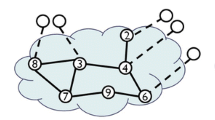Abstract
In recent years, the collection of data from social networks has increased sharply due to the diffusion of the internet and portable electronic devices. Data from social networks may represent a useful information source to investigate user opinions on web pages. Social network users can declare their preferences by clicking “Like” on a web page. This paper focuses on user’s “Likes” on social network pages by collecting the information given by users to social network pages with similar contents. Building on the user’s propensity to “Like” pages with analogous content, we suggest a procedure to assign a plausible opinion to pages that the user did not “Like.” Using this procedure, the absence of “Like” on a social network page is assigned with a negative (“Dislike”) or a neutral (“Nothing”) opinion. An application of the approach to data from social network pages on Italian television channels is shown.
Similar content being viewed by others
References
Baars H, Kemper HG (2008) Management support with structured and unstructured data—an integrated business intelligence framework. Inf Syst Manag 25(2):132–148
Carlin JB, Li N, Greenwood P, Coffey C (2003) Tools for analyzing multiple imputed datasets. Stata J 3(3):226–244
Chen X, Vorvoreanu M, Madhavan KPC (2014) Mining social media data for understanding students’ learning experiences. IEEE Trans Learn Technol 7(3):246–259
Cubeyou (2014) How Pharmaceutical Market Customers Benchmark Against Average Italian People. Industry Report, 11/2014, Cubeyou Inc., Redwood City, CA, USA
Griffiths M, McLean R (2015) Unleashing corporate communications via social media: a UK study of brand management and conversations with customers. J Cust Behav 14(2):147–162
Howell DC (2008) The analysis of missing data. Handbook of social science methodology 208–224
Huisman M (2009) Imputation of missing network data: some simple procedures. J Soc Struct 10(1):1–29
Kaplan AM, Haenlein M (2010) Users of the world, unite! The challenges and opportunities of Social Media. Bus Horiz 53(1):59–68
Kossinets G (2006) Effects of missing data in social networks. Soc Netw 28(3):247–268
Little RJA (1988) A test of missing completely at random for multivariate data with missing values. J Am Stat Assoc 83(404):1198–1202
Mahrt M, Scharkow M (2013) The value of big data in digital media research. J Broadcast Electron Media 57(1):20–33
Raghunathan TE (2004) What do we do with missing data? Some options for analysis of incomplete data. Annu Rev Public Health 25:99–117
Robins G, Pattison P, Woolcock J (2004) Missing data in networks: exponential random graph (p*) models for networks with non-respondents. Soc Netw 26:257–283
Rubin DB (1976) Inference and missing data. Biometrika 63:581–592
Santoro E (2009) Web 2.0 e Medicina: come social network, podcast, wiki e blog trasformano la comunicazione, l’assistenza e la formazione in sanità. Milano: Il pensiero scientifico Editore
Schafer JL, Graham JW (2002) Missing data: our view of the state of the art. Psychol Methods 7(2):147–177
Shah DV, Cappella JN, Neuman WR (2015) Big data, digital media, and computational social science: possibilities and perils. Ann Am Acad Polit Soc Sci 659(1):6–13
Sharma R, Magnani M, Montesi D (2016) Effects of missing data in multilayer networks. Soc Netw Anal Min 6(1):69
Stieglitz S, Dang-Xuan L (2013) Social media and political communication: a social media analytics framework. Soc Netw Anal Min 3(4):1277–1291
Stieglitz S, Mirbabaie M, Ross B, Neuberger C (2018) Social media analytics—challenges in topic discovery, data collection, and data preparation. Int J Inf Manage 39:156–168
Stork D, Richards WD (1992) Nonrespondents in communication network studies: problems and possibilities. Group Org Manage 17(2):193–209
Author information
Authors and Affiliations
Corresponding author
Additional information
Publisher's Note
Springer Nature remains neutral with regard to jurisdictional claims in published maps and institutional affiliations.
Rights and permissions
About this article
Cite this article
Mariani, P., Marletta, A., Mussini, M. et al. A missing value approach to social network data: “Dislike” or “Nothing”?. Comput Manag Sci 17, 569–583 (2020). https://doi.org/10.1007/s10287-020-00381-6
Received:
Accepted:
Published:
Issue Date:
DOI: https://doi.org/10.1007/s10287-020-00381-6




